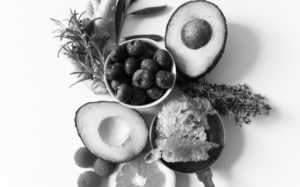Natural shampoo bars have deep roots in the day to day lives of ancient civilizations. In India, the natural system of Ayurveda guided people to use herbs and natural ingredients to cleanse, condition and nourish their hair. Natural substances like soapnuts and herbs were often used to clean the scalp and hair in Northern India, Nepal and beyond. In parts of Europe, soap-based shampoos became popular during the 19th century. These early shampoo bars were made from a mixture of natural oils and fats which were combined with lye (sodium hydroxide) to create a solid soap-like product that could cleanse the hair.
 The birth of liquid shampoo.
The birth of liquid shampoo.
The popularity of liquid shampoos grew in the early 20th century with Procter & Gamble leading the way with the introduction of a synthetic detergent-based shampoo called “Drene”. This launch, sometime in the 1930s, marked a significant shift away from traditional natural bar soap-based products. Liquid shampoos were marketed as more convenient and easier to use than solid bars. Because of this, shampoo bars quickly fell out of favour during the 20th century as more liquid shampoo products aggressively flooded the market.
Shampoo and conditioner bars have regained popularity in recent years as a more environmentally friendly alternative to traditional liquid shampoo and conditioner. One of the main reasons for the resurgence of shampoo bars is their reduced environmental impact. With concerns about plastic waste and the carbon footprint of transportation, shampoo bars offer a more sustainable alternative. They are often sold in minimal or recyclable packaging, and eliminate the need for plastic bottles that can end up in landfills or oceans.
 The rising tide of waterless beauty.
The rising tide of waterless beauty.
The birth of the waterless beauty trend has also contributed to the resurgence of natural shampoo bars on the market. Waterless beauty, also known as “waterless skincare” or “waterless cosmetics,” refers to an innovative category of personal care and beauty products that are formulated without using water as a primary filler or binding ingredient. Production methods are with alternative liquid bases or use dry, powdered, or concentrated ingredients. This reduces the need for water both in the product itself and in the manufacturing process. The main driver is to eliminate the wasteful use of a precious natural resource. Waterless beauty is a part of a broader movement toward sustainability, conservation of resources, and reducing the environmental impact of beauty and skincare products. One bar makes a difference. A single shampoo bar is equivalent to 2 full sized bottles of liquid shampoo and tend to have a longer shelf life because they are less susceptible to microbial growth. Waterless beauty products, like shampoo bars, are also often more convenient for travel, as they are less likely to leak or spill and are not subject to liquid restrictions when flying.
 The path to natural ingredients.
The path to natural ingredients.
With the return of homesteading, do-it-yourself culture and eco-consciousness, there has been a resurgence of interest in natural ingredients, and the potential benefits. This desire to learn more and make mindful choices has led to a renewed interest in shampoo bars that are packed with botanical extracts, clays and nourishing natural ingredients.
Natural shampoo bars have a long history that spans various cultures and time periods. While they fell out of favor during the rise of liquid shampoos in the 20th century, they have made a comeback in recent years due to growing environmental awareness and the desire for more natural and sustainable hair care options. If you are thinking of making the switch from liquid to solid, rest assured that using a shampoo bar is relatively straightforward.
 Work with wet hair. Start by wetting the shampoo bar and rubbing it between your hands to create a lather. Apply shampoo to the hair by gently rubbing the wet shampoo bar or your hands (if you’ve created lather) directly onto your wet hair. You can apply it to the roots, the length of your hair, and the ends. Use a gentle, massaging motion to work the shampoo into your hair and scalp. Continue massaging your hair and scalp to create a rich lather. This helps distribute the shampoo and cleanse your hair effectively. Thoroughly rinse your hair thoroughly with water to ensure the shampoo is washed out. Repeat if necessary. Allow shampoo to dry out after use and avoid leaving it in a pool of water for this can cause the bar to dissolve more quickly. Depending on your hair type and preference, you can follow up with a conditioner bar or your regular conditioner. Simply wet the conditioner bar and apply it to the ends of your hair, then rinse it out.
Work with wet hair. Start by wetting the shampoo bar and rubbing it between your hands to create a lather. Apply shampoo to the hair by gently rubbing the wet shampoo bar or your hands (if you’ve created lather) directly onto your wet hair. You can apply it to the roots, the length of your hair, and the ends. Use a gentle, massaging motion to work the shampoo into your hair and scalp. Continue massaging your hair and scalp to create a rich lather. This helps distribute the shampoo and cleanse your hair effectively. Thoroughly rinse your hair thoroughly with water to ensure the shampoo is washed out. Repeat if necessary. Allow shampoo to dry out after use and avoid leaving it in a pool of water for this can cause the bar to dissolve more quickly. Depending on your hair type and preference, you can follow up with a conditioner bar or your regular conditioner. Simply wet the conditioner bar and apply it to the ends of your hair, then rinse it out.
